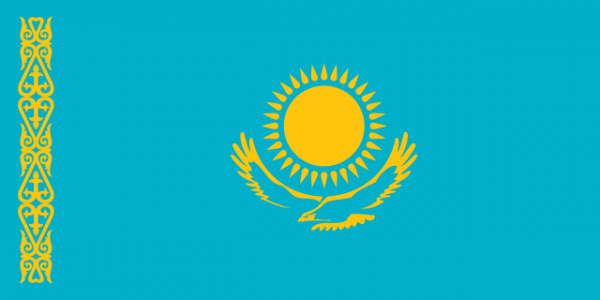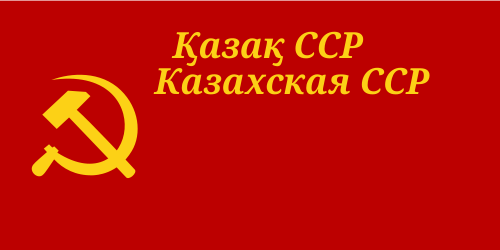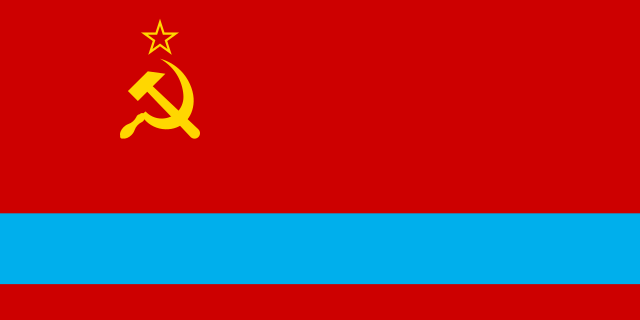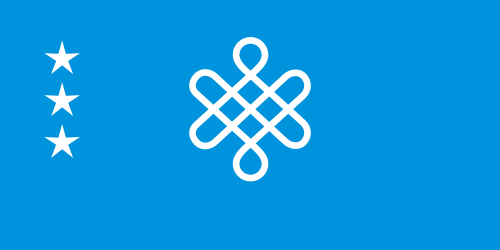
Given its gold and sky blue colour scheme, it’s a very distinctive flag design. The flag of Kazakhstan is, visually, also one of my favourite flags along with the flag of Turkmenistan. That shade of blue is so distinctive and unique in the world of flags!
Symbolism of the Flag of Kazakhstan:
The ornamental pattern down the left-hand side of the flag is called “koshkar muiz” which means “the horns of the ram.” It represents the art and cultural traditions of the Kazakh people, with this pattern used all over Kazakhstan – in construction, interior design, menus, and even on clothing! If you go to Kazakhstan and keep your eyes open (or even if you don’t…), you’ll definitely see this design.
The shade of blue is so distinctive and unique in the world of flags! Incidentally, it’s the same blue used for their passports, so it’s dead easy to spot a Kazakh passport a mile away. Amidst all the navy and maroon passports, the sky blue really stands out. Officially, this shade of blue represents Turkic people, who traditionally worshipped the sky before Islam was introduced. The one colour represents the unity of the people, which is appropriate given how Kazakhstan is one of the most diverse countries in the world.
The Steppe Eagle, which makes up part of the central design, is a symbol that has appeared on tribal flags for centuries. It is supossed to represent freedom, power, independence, and the power of the state. The sun, which rests atop the eagle, has thirty-two rays in the shape of grains of wheat. This may seem ironic, given that much of Kazakhstan appears to be barren desert. However, this symbol represents the prosperity of the land – it does make sense given that the country is one of the largest wheat producers in the world.
For a more detailed look at the meaning of the Flag of Kazakhstan, we recommend looking at this page from the Kazakh President’s office.
Flags of the Kazakh SSR (Soviet Socialist Republic)


The colour scheme was inherited from the flag of the Kazakh SSR, which had the standard gold hammer and sickle alongside the star of the Communist Party, all in the top left hand corner of a red field.
Although all the flags of the Soviet Republics are very similar – making it quite a task to memorise them all and remember which one is which – the colours of the Kazakh SSR’s flag do stand out like they do on the modern flag. While the rest of the flag is very standard, the band across the bottom third of the flag is in that iconic, unique sky blue.
In case you’re wondering about the writing on the first flag, they both say Kazakh SSR (Soviet Socialist Republic). The top one is in Kazakh, while the bottom is in Russian. These both remain official languages of Kazakhstan to this day. As a fun fact, the Kazakh language was written using the Latin alphabet for a few years – this meant that the Kazakh on the flag was written in Latin letters between 1937 and 1940.
Variations on the flag of Kazakhstan
Between 1917 and 1953 when this flag was adopted, there were several other variations on the flag, although none of them incorporate the sky blue colour. However, it’s thought that the iconic colour scheme on the later Soviet and the modern flag was actually taken from the flag of the Kazakh Khanate.

The Kazakh Khanate existed between the 15th and the 19th centuries, and was located roughly on the territory of Kazakhstan today.
While we cannot be exactly sure of exactly what their flag was – and it’s very likely that they didn’t just have one unifying flag as countries do now – the flag that is generally assumed to be theirs is a field of our favourite sky blue. The white design is that of the Turkic infinate knot.





